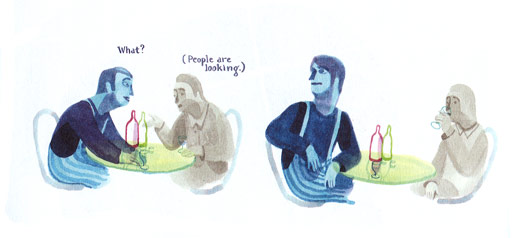The Wrong Place by Brecht Evens

If you pick up and look at this book, the first thing that will jump out at you is the art. On the one hand, the wild watercolors seem full of raw energy, while on the other hand being very controlled and intentional. It’s an amazing feat that Evens pulls off. Still, we have all seen comics that have wowed us visually, but left us unfulfilled in all other respects. To adapt a line from The New Yorker film critic David Denby, “we may be ravished by the” art, “but we’re famished by everything else” (March 28, 2011). Fortunately, this common disappointment is not true of The Wrong Place.
There are many things I could point out, but what I want to focus on is the characterization. The Wrong Place is the story of two friends: Gary and Robbie. Gary is rule-bound and gray (literally) while Robbie is an overgrown child or a modern Bacchus. It would be easy to overdo characters like this. You could make Gary grumpy and caustic, while Robbie could be reckless and unmindfully dangerous. But Evens doesn’t do that.

While Robbie may be noticeably unencumbered by the worries of adulthood, he’s actually a decent guy. Sure, he misses Gary’s party, but he takes the time to catch up with him later. And while he woos women, he’s never a schmuck about it. It’s hard not to like him, actually. And we begin to see why everyone in the story is so enamored of him.
And Gary is no sad sack. Sure, he’s nowhere near as full of life as his friend, but he isn’t bitterly jealous or shut off from the world. The book starts out with a party that Gary throws and his character is defined from the outset. First he tells a liquor store clerk that she can’t come to the party, then we see that he has the chairs in his apartment lined in neat rows, and later he tells three women that they have to smoke underneath the oven exhaust fan. So we see that Gary is no wild and crazy guy and is instead full of little rules. Still, he wants to have a party. He keeps encouraging people to drink and dance. But they don’t. The lifelessness of the party is not Gary’s fault entirely. All anyone there talks about is Robbie. In fact, that seems to be the only reason people came to Gary’s party in the first place, for a chance to see Robbie. And so while we understand that Gary is a tepid man, we also see that everyone else is more pitiful than him. Gary at least tries to have fun on his own and live in the present moment (within certain rules of course). No one else is able to do that. The book ends with a phone conversation in a hair salon. The woman in the salon is talking with her friend who spent a night with Robbie. Everyone in the salon looks over and listens to the conversation. No one is in their own life; they are all straining to get a little piece of Robbie. So by contrast, Gary seems brave and noble. He is trying to live his own life, no matter how small. And while we see how unable he is to break out of his own limitations, we also admire him in a small way.
It is this complexity that really makes this book something special. That combined with the amazing art make this book truly exceptional.
(written March 28, 2011)
 This work by http://www.nijomu.com is licensed under a Creative Commons Attribution-NonCommercial 4.0 International License. |